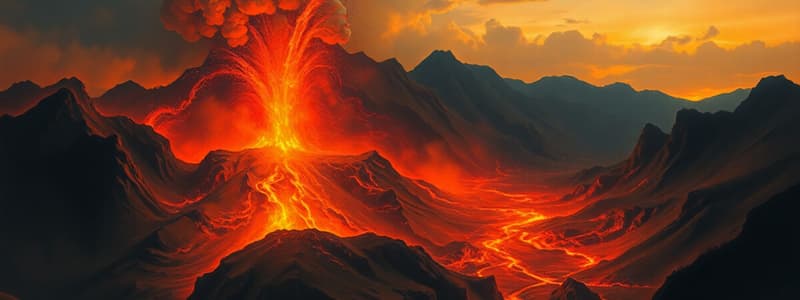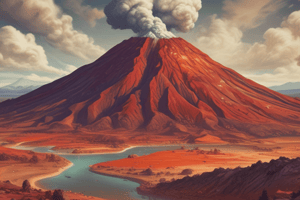Podcast
Questions and Answers
Which method is NOT typically used for predicting volcanic eruptions?
Which method is NOT typically used for predicting volcanic eruptions?
- Gas monitoring
- Seismic monitoring
- Satellite weather analysis (correct)
- Ground deformation measurements
What hazardous effect do pyroclastic flows have during volcanic eruptions?
What hazardous effect do pyroclastic flows have during volcanic eruptions?
- They cause rapid temperature drops.
- They primarily affect air travel.
- They create ash falls that fertilize soil.
- They can destroy land and property. (correct)
What role do historical records play in understanding volcanic activity?
What role do historical records play in understanding volcanic activity?
- They only focus on gas emissions.
- They eliminate the need for modern monitoring.
- They serve as a baseline for identifying future patterns. (correct)
- They replace the need for mathematical models.
Which of the following is a key factor in predicting the timing of volcanic eruptions?
Which of the following is a key factor in predicting the timing of volcanic eruptions?
Which volcanic hazard can sweep away entire communities during heavy rain?
Which volcanic hazard can sweep away entire communities during heavy rain?
Which gas is NOT typically monitored for volcanic activity?
Which gas is NOT typically monitored for volcanic activity?
What is the most immediate danger posed by ash falls during a volcanic eruption?
What is the most immediate danger posed by ash falls during a volcanic eruption?
Which of the following statements about predicting eruptions is true?
Which of the following statements about predicting eruptions is true?
What primarily drives volcanic eruptions?
What primarily drives volcanic eruptions?
Which type of magma tends to cause more explosive eruptions?
Which type of magma tends to cause more explosive eruptions?
What is a caldera?
What is a caldera?
Which type of volcano is characterized by alternating layers of lava flows and pyroclastic deposits?
Which type of volcano is characterized by alternating layers of lava flows and pyroclastic deposits?
What role do dissolved gases play in volcanic eruptions?
What role do dissolved gases play in volcanic eruptions?
What type of volcanic monitoring is used to assess potential eruptions?
What type of volcanic monitoring is used to assess potential eruptions?
Which volcanic structure is formed from fluid lava flows?
Which volcanic structure is formed from fluid lava flows?
What is the effect of plate tectonics on volcanic activity?
What is the effect of plate tectonics on volcanic activity?
What is the primary focus of immediate relief efforts in disaster response strategies?
What is the primary focus of immediate relief efforts in disaster response strategies?
Which strategy emphasizes using local knowledge and expertise in recovery efforts after a disaster?
Which strategy emphasizes using local knowledge and expertise in recovery efforts after a disaster?
What role does technology play in disaster response strategies?
What role does technology play in disaster response strategies?
Which of the following strategies is aimed at reducing future risks after a disaster?
Which of the following strategies is aimed at reducing future risks after a disaster?
What type of groups should receive priority attention in disaster response efforts?
What type of groups should receive priority attention in disaster response efforts?
Which of the following is classified as a meteorological hazard?
Which of the following is classified as a meteorological hazard?
What is a significant impact of natural disasters on the environment?
What is a significant impact of natural disasters on the environment?
Which action is NOT typically part of disaster preparedness?
Which action is NOT typically part of disaster preparedness?
How does climate change primarily affect natural disasters?
How does climate change primarily affect natural disasters?
Which of the following impacts natural disasters have on water sources?
Which of the following impacts natural disasters have on water sources?
What is a key component of an effective evacuation plan?
What is a key component of an effective evacuation plan?
Which type of hazard includes events like landslides and tsunamis?
Which type of hazard includes events like landslides and tsunamis?
What strategy can communities adopt to enhance disaster preparedness?
What strategy can communities adopt to enhance disaster preparedness?
Flashcards
Volcanic Eruption Cause
Volcanic Eruption Cause
Molten rock (magma) rising to the Earth's surface, driven by pressure from dissolved gases.
Explosive Eruption Link
Explosive Eruption Link
Eruptions are more explosive when magma has high silica content and is viscous.
Shield Volcano Shape
Shield Volcano Shape
Broad, gently sloping volcano formed by fluid lava flows.
Composite Volcano Structure
Composite Volcano Structure
Signup and view all the flashcards
Volcanic Eruption Triggers
Volcanic Eruption Triggers
Signup and view all the flashcards
Subduction Zone Volcanoes
Subduction Zone Volcanoes
Signup and view all the flashcards
Caldera Formation
Caldera Formation
Signup and view all the flashcards
Volcanic Monitoring Aim
Volcanic Monitoring Aim
Signup and view all the flashcards
Volcanic Monitoring
Volcanic Monitoring
Signup and view all the flashcards
Magma Movement
Magma Movement
Signup and view all the flashcards
Volcanic Gas Monitoring
Volcanic Gas Monitoring
Signup and view all the flashcards
Ground Deformation
Ground Deformation
Signup and view all the flashcards
Lava Flow
Lava Flow
Signup and view all the flashcards
Pyroclastic Flow
Pyroclastic Flow
Signup and view all the flashcards
Volcanic Hazard
Volcanic Hazard
Signup and view all the flashcards
Predicting Eruptions
Predicting Eruptions
Signup and view all the flashcards
Disaster Response Strategies
Disaster Response Strategies
Signup and view all the flashcards
Immediate Relief Efforts
Immediate Relief Efforts
Signup and view all the flashcards
Restoration and Rehabilitation
Restoration and Rehabilitation
Signup and view all the flashcards
Vulnerable Groups
Vulnerable Groups
Signup and view all the flashcards
Community Involvement
Community Involvement
Signup and view all the flashcards
Natural Disaster
Natural Disaster
Signup and view all the flashcards
Types of Natural Disasters
Types of Natural Disasters
Signup and view all the flashcards
Disaster Preparedness
Disaster Preparedness
Signup and view all the flashcards
Climate Change & Disasters
Climate Change & Disasters
Signup and view all the flashcards
Environmental Impacts
Environmental Impacts
Signup and view all the flashcards
Disaster Preparedness Example
Disaster Preparedness Example
Signup and view all the flashcards
Early Warning Systems
Early Warning Systems
Signup and view all the flashcards
Resilient Infrastructure
Resilient Infrastructure
Signup and view all the flashcards
Study Notes
Causes of Volcanic Eruptions
- Magma, a molten rock beneath the Earth's surface, is the primary driver of volcanic eruptions.
- Differences in magma composition influence eruption style and explosiveness.
- Higher silica content magma is typically more viscous and leads to more explosive eruptions.
- Lower silica content magma is less viscous and tends toward effusive eruptions.
- Dissolved gases, primarily water vapor, play a crucial role in the explosiveness of eruptions.
- Pressure from dissolved gases builds as magma rises, ultimately fueling eruptions.
- The rate of ascent and the presence of pre-existing fractures in the Earth's crust affect magma's ability to reach the surface.
- Interactions between magma and surrounding rocks can influence eruption dynamics. Water in country rocks can add to the erupted volatile content.
- Plate tectonics significantly influence where volcanoes form and erupt.
- Subduction zones, where one tectonic plate slides beneath another, are a major source of volcanic activity.
- Divergent plate boundaries, where plates move apart, also create volcanic activity.
- Some volcanism occurs at hotspots, points of intense heat deep within the Earth's mantle.
Types of Volcanoes
- Volcanoes are classified by their shape and eruptive style, primarily based on the nature of their erupted products. This includes lava composition and the interplay between magma and the surrounding environment.
- Shield volcanoes are broad, gently sloping structures formed by effusive eruptions of fluid lava flows.
- Cinder cones are small, steep-sided volcanoes built from ejected lava fragments.
- Composite volcanoes (stratovolcanoes) are large, cone-shaped structures formed by alternating layers of lava flows and pyroclastic deposits. They frequently erupt explosively, potentially with highly dangerous pyroclastic flows.
- Calderas are large depressions formed either by the collapse of a volcano's summit after a massive eruption, or large-volume magma chamber emptying.
- Lava domes are bulbous, steep-sided structures formed by highly viscous lava. Eruptions from these are typically dome-building, or dome collapse events.
Eruption Prediction Methods
- Volcanic monitoring involves a multi-faceted approach to assess potential eruptions.
- Geophysical methods, including ground deformation measurements (using tiltmeters, GPS), and seismic monitoring (detecting increases in tremor or earthquake frequency) provide key indicators of magma movement below the surface.
- Gas monitoring tracks the release of volcanic gases, particularly sulfur dioxide (SO2) or carbon dioxide (CO2), which can increase in concentration when magma rises.
- Changes in temperature, ground-surface heat flow, or changes in the electrical properties of the ground, are also important clues, but often require sophisticated analysis.
- Historical records of past eruptions provide a baseline for understanding patterns. Learning and applying lessons from previous eruptions is valuable, and can provide a predictive basis.
- Predicting eruptions involves analyzing multiple data sets from these monitoring techniques over time.
- A clear understanding of the specific volcano in question and its unique characteristics is critical. Each volcano has specific behavioral patterns.
- Precise prediction of the exact time and day of an eruption is often not feasible, even with advanced monitoring. Scientists target predicting when eruptions are imminent.
Volcanic Hazards
- Volcanic eruptions pose significant hazards that impact surrounding environments.
- Lava flows, streams of molten rock, can destroy land and property.
- Pyroclastic flows, scorching currents of hot gas and volcanic debris, can cause significant damage and death, often traveling rapidly down volcanic slopes.
- Ash falls can cause respiratory problems for humans. It can also impact ground and air travel. The ash can also damage buildings.
- Lahars, volcanic mudflows, can sweep away entire communities and cause widespread devastation, often triggered by heavy rain or melting snow.
- Volcanic gases like sulfur dioxide, carbon dioxide, and hydrogen sulfide, can be hazardous to human health, impacting air quality and potentially causing poisoning.
- Volcanic tsunamis can form when large volumes of volcanic material are released into a body of water and induce significant waves.
- Long term consequences from eruptions include changes in weather patterns and the cooling of the planet, which can influence globally occurring climate.
- Volcanic activity has a variety of indirect effects, like potentially disrupting agriculture, and contaminating water supplies.
Studying That Suits You
Use AI to generate personalized quizzes and flashcards to suit your learning preferences.




